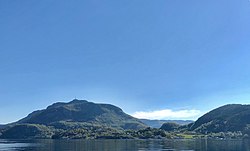Fister (municipality)
Fister Municipality
Fister herred | |
|---|---|
 View of Fister from the fjord | |
 Rogaland within Norway | |
 Fister within Rogaland | |
| Coordinates: 59°10′29″N 06°03′17″E / 59.17472°N 6.05472°E | |
| Country | Norway |
| County | Rogaland |
| District | Ryfylke |
| Established | 1 July 1884 |
| • Preceded by | Hjelmeland og Fister Municipality |
| Disestablished | 1 Jan 1965 |
| • Succeeded by | Finnøy and Hjelmeland municipalities |
| Administrative centre | Fister |
| Area (upon dissolution) | |
• Total | 47 km2 (18 sq mi) |
| Population (1965) | |
• Total | 713 |
| • Density | 15/km2 (39/sq mi) |
| Time zone | UTC+01:00 (CET) |
| • Summer (DST) | UTC+02:00 (CEST) |
| ISO 3166 code | NO-1132[1] |
Fister is a former municipality in Rogaland county, Norway. The 47-square-kilometre (18 sq mi) municipality existed from 1884 until 1965. It was located in what is now the present-day municipalities of Stavanger and Hjelmeland. The administrative centre of the municipality was the village of Fister, where the Fister Church is located. The municipality encompassed the western coast of mainland along the Fisterfjorden plus the islands to the west of the mainland, including the western part of Randøy and Halsnøya.[2]
History
[edit]
The municipality of Fister was established on 1 July 1884 when the municipality of Hjelmeland og Fister was divided into two municipalities: Hjelmeland and Fister. Initially, Fister had 832 residents.[3]
During the 1960s, there were many municipal mergers across Norway due to the work of the Schei Committee. On 1 January 1965, the municipality of Fister was dissolved. The western part of Fister, known as the Fister islands (Fisterøyene), (population: 246) was merged into the municipality of Finnøy. The eastern part of Fister which included part of Randøy island and the mainland part of the municipality (population: 467) was merged with Hjelmeland and Årdal municipalities to form the new, larger municipality of Hjelmeland.[3]
Name
[edit]The municipality (originally the parish) is named after the old Fister farm (Old Norse: Fístr) since the first Fister Church was built there. The name probably comes from the word fístr which means "windy" or "hardy". It is probably related to the verb fise which means "to pass gas".[4]
Government
[edit]While it existed, this municipality was responsible for primary education (through 10th grade), outpatient health services, senior citizen services, unemployment, social services, zoning, economic development, and municipal roads. During its existence, this municipality was governed by a municipal council of directly elected representatives. The mayor was indirectly elected by a vote of the municipal council.[5]
Municipal council
[edit]The municipal council (Herredsstyre) of Fister was made up of representatives that were elected to four year terms. The party breakdown of the final municipal council was as follows:
| Party name (in Norwegian) | Number of representatives | |
|---|---|---|
| Local List(s) (Lokale lister) | 13 | |
| Total number of members: | 13 | |
| Party name (in Norwegian) | Number of representatives | |
|---|---|---|
| Local List(s) (Lokale lister) | 13 | |
| Total number of members: | 13 | |
| Party name (in Norwegian) | Number of representatives | |
|---|---|---|
| Local List(s) (Lokale lister) | 13 | |
| Total number of members: | 13 | |
| Party name (in Norwegian) | Number of representatives | |
|---|---|---|
| Local List(s) (Lokale lister) | 12 | |
| Total number of members: | 12 | |
| Party name (in Norwegian) | Number of representatives | |
|---|---|---|
| Local List(s) (Lokale lister) | 12 | |
| Total number of members: | 12 | |
| Party name (in Norwegian) | Number of representatives | |
|---|---|---|
| Local List(s) (Lokale lister) | 12 | |
| Total number of members: | 12 | |
| Party name (in Norwegian) | Number of representatives | |
|---|---|---|
| Local List(s) (Lokale lister) | 12 | |
| Total number of members: | 12 | |
| Note: Due to the German occupation of Norway during World War II, no elections were held for new municipal councils until after the war ended in 1945. | ||
See also
[edit]References
[edit]- ^ Bolstad, Erik; Thorsnæs, Geir, eds. (26 January 2023). "Kommunenummer". Store norske leksikon (in Norwegian). Kunnskapsforlaget.
- ^ Store norske leksikon. "Fister" (in Norwegian). Retrieved 19 January 2016.
- ^ a b Jukvam, Dag (1999). Historisk oversikt over endringer i kommune- og fylkesinndelingen (PDF) (in Norwegian). Statistisk sentralbyrå. ISBN 9788253746845.
- ^ Rygh, Oluf (1915). Norske gaardnavne: Stavanger amt (in Norwegian) (10 ed.). Kristiania, Norge: W. C. Fabritius & sønners bogtrikkeri. pp. 309–310.
- ^ Hansen, Tore; Vabo, Signy Irene, eds. (20 September 2022). "kommunestyre". Store norske leksikon (in Norwegian). Kunnskapsforlaget. Retrieved 1 January 2023.
- ^ "Kommunevalgene 1963" (PDF) (in Norwegian). Oslo: Statistisk sentralbyrå. 1964. Retrieved 14 July 2020.
- ^ "Kommunevalgene og Ordførervalgene 1959" (PDF) (in Norwegian). Oslo: Statistisk sentralbyrå. 1960. Retrieved 14 July 2020.
- ^ "Kommunevalgene og Ordførervalgene 1955" (PDF) (in Norwegian). Oslo: Statistisk sentralbyrå. 1957. Retrieved 14 July 2020.
- ^ "Kommunevalgene og Ordførervalgene 1951" (PDF) (in Norwegian). Oslo: Statistisk sentralbyrå. 1952. Retrieved 14 July 2020.
- ^ "Kommunevalgene og Ordførervalgene 1947" (PDF) (in Norwegian). Oslo: Statistisk sentralbyrå. 1948. Retrieved 14 July 2020.
- ^ "Kommunevalgene og Ordførervalgene 1945" (PDF) (in Norwegian). Oslo: Statistisk sentralbyrå. 1947. Retrieved 14 July 2020.
- ^ "Kommunevalgene og Ordførervalgene 1937" (PDF) (in Norwegian). Oslo: Statistisk sentralbyrå. 1938. Retrieved 14 July 2020.

